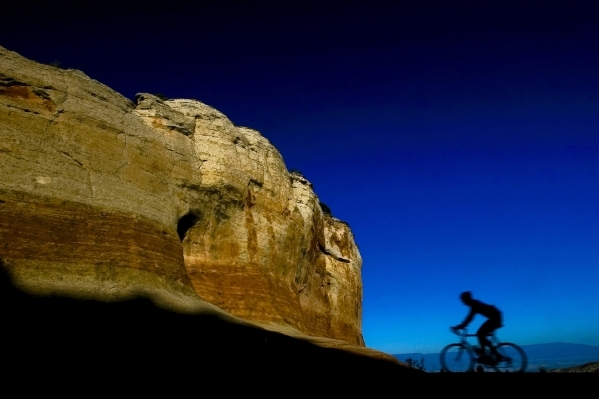Colorado gem offers grand sightseeing, recreational options

A logical halfway stopover on the long journey from Las Vegas to Denver, Grand Junction, Colo., is a worthy destination in its own right. The city enjoys a high-desert setting in a rich agricultural valley surrounded by scenic splendor and myriad recreational opportunities.
To reach Grand Junction, drive north into Utah on Interstate 15. North of Cedar City at Cove Fort, turn east on Interstate 70 toward the Rocky Mountains. The road cuts through ranch lands, wooded foothills and badlands to Green River, Utah. Soon the route enters the Grand River Valley, spanning more than 60 miles over the border into Colorado. Known as the Western Front, the foothills of the mighty mountains begin to rise just beyond Grand Junction as I-70 continues toward Denver.
Grand Junction was born in 1881 when the area west of the Rockies was opened to settlement of former Ute homeland, just as soon as the natives were moved into reservations. Situated near the confluence of the Gunnison and Colorado rivers, Grand Junction soon became the seat of a new county in the middle of a fruitful area now famous for its productive orchards and vineyards, as well as for its livestock. The pioneers would not recognize their town today, as it is home to around 60,000 and is a service center to a much larger population in smaller communities nearby.
The town enjoys a beautiful setting with the mountains in view to the east, the canyons and red rock formations of Colorado National Monument to the west, the majestic Grand Mesa to the south and the two rivers. It is popular for a variety of recreational pursuits, including fishing, hunting, camping, hiking, river rafting, mountain biking and winter sports. The region boasts 300 fishing lakes and streams, hundreds of miles of trails for hikers, bikers, horseback riders and off-roaders, a selection of public and private campgrounds, guest ranches and facilities for downhill and cross-country skiing and snowmobiling.
Scenic drives for fall color near Grand Junction draw visitors into Uncompahgre and Grand Mesa national forests and Colorado National Monument, where the high country flares early with bright hues among the aspens, oaks and maples. Seasonal color follows later along streams and rivers at lower elevations, extending the autumnal displays.
Downtown Grand Junction is walkable with charming vintage buildings, attractive foliage and displays of more than 100 outdoor sculptures along Main Street. Downtown offers varied shopping, art galleries and many dining options, some with dog-friendly outdoor seating.
The Museum of Western Colorado on Ute Street has been a downtown favorite for 50 years. Open to visitors year-round, the museum offers glimpses of the area’s long history from prehistoric Anasazi farmers to modern oil and uranium miners. Visitors explore displays of Anasazi artifacts, Fremont and Ute rock art, Old West firearms, pioneer implements and re-created rooms from yesteryear. The museum is associated with the nearby Dinosaur Journey Museum and the Cross Orchards Historic Site.
The farm-to-table movement is very active in the Grand Junction area. Farmers markets that help bring attention to the wonderful flavors of local fruit continue through September. The Western Front of Colorado is recognized as a premier region for growing grapes and producing wine, encompassing two federally designated American Viticultural Areas, one in the Grand Valley. Visitors to Grand Junction are surrounded by vineyards, wine cellars and tasting rooms featuring wines from 22 local wineries.
Informational signs along Colorado highways indicate designated “Colorado Wine Trails.” Around Grand Junction, I-70 and side roads are marked for enthusiasts following the trail.
— Margo Bartlett Pesek’s Trip of the Week column appears on Sundays.












